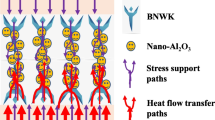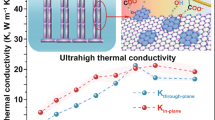Abstract
Highly thermally conductive yet electrically insulating polymer/boron nitride nanosheets (BNNS) composites are crucially significant to tackle the “overheating” concern of microelectronics. However, the superiority of BNNS has not been fully exploited due to the large thermal resistance in polymer-fillers and fillers-fillers interfaces. Rational construction of BNNS-based nanohybrids is considered as a feasible and promising strategy, but often suffers from complicated preparation process and high cost. Herein, we reported a facile electrostatic self-assembly approach to successfully construct the BNNS-based nanohybrids, and fabricated a series of highly thermally conductive cellulose nanofibers (CNFs)-based composites. It was found that the positively charged thermally conductive nanoparticles (e.g., nanodiamond and modified Al2O3) can be stably adsorbed on the surface of BNNS, serving as a “bridge” to effectively strengthen the thermal conduction pathway in both CNF/BNNS and BNNS/BNNS interfaces. Moreover, benefiting from their highly oriented “brick–mortar” layered structure and strong interfacial interaction between CNFs matrix and BNNS-based nanohybrids, the resultant flexible CNFs-based composites exhibit superior thermal conductivity. This work offers a general approach for constructing BNNS-based nanohybrids, which shows great promise in developing advanced thermally conductive composites for practical applications in thermal management field.
Graphical abstract
BNNS-based nanohybrids were constructed by electrostatic self-assembly for fabricating highly thermally conductive composites.









Similar content being viewed by others
References
Pan D, Dong J, Yang G, Su F, Chang B, Liu C et al (2021) Ice template method assists in obtaining carbonized cellulose/boron nitride aerogel with 3D spatial network structure to enhance the thermal conductivity and flame retardancy of epoxy-based composites. Adv Compos Hybrid Mater. https://doi.org/10.1007/s42114-021-00362-6
Dai W, Lv L, Lu J, Hou H, Yan Q, Alam FE et al (2019) A paper-like inorganic thermal interface material composed of hierarchically structured graphene/silicon carbide nanorods. ACS Nano 13(2):1547–1554
Yang X, Liang C, Ma T, Guo Y, Kong J, Gu J et al (2018) A review on thermally conductive polymeric composites: classification, measurement, model and equations, mechanism and fabrication methods. Adv Compos Hybrid Mater 1(2):207–230
Guo Y, Qiu H, Ruan K, Zhang Y, Gu J (2021) Hierarchically multifunctional polyimide composite films with strongly enhanced thermal conductivity. Nano-Micro Lett 14(1):26
Huang X, Zhi C, Jiang P, Colberg D, Bando Y, Tanaka T (2013) Polyhedral oligosilsesquioxane-modified boron nitride nanotube based epoxy nanocomposites: an ideal dielectric material with high thermal conductivity. Adv Funct Mater 23(14):1824–1831
Li M, Wang M, Hou X, Zhan Z, Wang H, Fu H et al (2020) Highly thermal conductive and electrical insulating polymer composites with boron nitride. Compos Part B Eng 184:107746
Lei C, Zhang Y, Liu D, Xu X, Wu K, Fu Q (2021) Highly thermo-conductive yet electrically insulating material with perpendicularly engineered assembly of boron nitride nanosheets. Compos Sci Technol 214:108995
Ma T-B, Ma H, Ruan K-P, Shi X-T, Qiu H, Gao S-Y, Gu J-W (2022) Thermally conductive polylactic acid composites with superior electromagnetic shielding performances via 3D printing technology. Chinese J Polym Sci 40:248–255
Kim G-H, Lee D, Shanker A, Shao L, Kwon MS, Gidley D et al (2015) High thermal conductivity in amorphous polymer blends by engineered interchain interactions. Nat Mater 14(3):295–300
Xu F, Bao D, Cui Y, Gao Y, Lin D, Wang X et al (2021) Copper nanoparticle-deposited graphite sheets for highly thermally conductive polymer composites with reduced interfacial thermal resistance. Adv Compos Hybrid Mater. https://doi.org/10.1007/s42114-021-00367-1
Burger N, Laachachi A, Ferriol M, Lutz M, Toniazzo V, Ruch D (2016) Review of thermal conductivity in composites: mechanisms, parameters and theory. Prog Polym Sci 61:1–28
Guo Y, Ruan K, Shi X, Yang X, Gu J (2020) Factors affecting thermal conductivities of the polymers and polymer composites: a review. Compos Sci Technol 193:108134
Fang H, Bai S-L, Wong CP (2016) “White graphene”—hexagonal boron nitride based polymeric composites and their application in thermal management. Compos Commun 2:19–24
Morishita T, Okamoto H (2016) Facile exfoliation and noncovalent superacid functionalization of boron nitride nanosheets and their use for highly thermally conductive and electrically insulating polymer nanocomposites. ACS Appl Mater Interfaces 8(40):27064–27073
Zhang L, Deng H, Fu Q (2018) Recent progress on thermal conductive and electrical insulating polymer composites. Compos Commun 8:74–82
Chen J, Huang X, Sun B, Jiang P (2019) Highly thermally conductive yet electrically insulating polymer/boron nitride nanosheets nanocomposite films for improved thermal management capability. ACS Nano 13(1):337–345
Hu D, Liu H, Ma W (2020) Rational design of nanohybrids for highly thermally conductive polymer composites. Compos Commun 21:100427
Zhou Y, Liu F, Chen C-Y (2019) Use of BN-coated copper nanowires in nanocomposites with enhanced thermal conductivity and electrical insulation. Adv Compos Hybrid Mater 2(1):46–50
Pullanchiyodan A, S. Nair K, Surendran KP (2017) Silver-decorated boron nitride nanosheets as an effective hybrid filler in PMMA for high-thermal-conductivity electronic substrates. ACS Omega 2(12):8825–8835
Ma M, Xu L, Qiao L, Chen S, Shi Y, He H et al (2020) Nanofibrillated cellulose/MgO@rGO composite films with highly anisotropic thermal conductivity and electrical insulation. Chem Eng J 392:123714
Yan H, Dai X, Ruan K, Zhang S, Shi X, Guo Y et al (2021) Flexible thermally conductive and electrically insulating silicone rubber composite films with BNNS@Al2O3 fillers. Adv Compos Hybrid Mater 4(1):36–50
Wang F, Zeng X, Yao Y, Sun R, Xu J, Wong C-P (2016) Silver nanoparticle-deposited boron nitride nanosheets as fillers for polymeric composites with high thermal conductivity. Sci Rep 6(1):19394
Chen C, Xue Y, Li Z, Wen Y, Li X, Wu F et al (2019) Construction of 3D boron nitride nanosheets/silver networks in epoxy-based composites with high thermal conductivity via in-situ sintering of silver nanoparticles. Chem Eng J 369:1150–1160
Han Y, Shi X, Yang X, Guo Y, Zhang J, Kong J et al (2020) Enhanced thermal conductivities of epoxy nanocomposites via incorporating in-situ fabricated hetero-structured SiC-BNNS fillers. Compos Sci Technol 187
Zhang Y, Choi JR, Park S-J (2017) Thermal conductivity and thermo-physical properties of nanodiamond-attached exfoliated hexagonal boron nitride/epoxy nanocomposites for microelectronics. Compos Part A Appl Sci Manuf 101:227–236
Wang K, Zhu X, Hu Y, Qiu S, Gu L, Wang C et al (2020) Stable anchoring and uniform distribution of SiO2 nanotubes on reduced graphene oxide through electrostatic self-assembly for ultra-high lithium storage performance. Carbon 167:835–842
Liu H, Zhang X, Zhu Y, Cao B, Zhu Q, Zhang P et al (2019) Electrostatic self-assembly of 0D–2D SnO2 quantum dots/Ti3C2Tx MXene hybrids as anode for lithium-ion batteries. Nano-Micro Lett 11(1):65
Xie H, Li P, Shao J, Huang H, Chen Y, Jiang Z et al (2019) Electrostatic self-assembly of Ti3C2Tx MXene and gold nanorods as an efficient surface-enhanced raman scattering platform for reliable and high-sensitivity determination of organic pollutants. ACS Sensors 4(9):2303–2310
Qian R, Yu J, Wu C, Zhai X, Jiang P (2013) Alumina-coated graphene sheet hybrids for electrically insulating polymer composites with high thermal conductivity. RSC Adv 3(38):17373–17379
Wang X, Wu P (2017) Preparation of highly thermally conductive polymer composite at low filler content via a self-assembly process between polystyrene microspheres and boron nitride nanosheets. ACS Appl Mater Interfaces 9(23):19934–19944
Zhang D-L, Liu S-N, Cai H-W, Feng Q-K, Zhong S-L, Zha J-W et al (2020) Enhanced thermal conductivity and dielectric properties in electrostatic self-assembly 3D pBN@nCNTs fillers loaded in epoxy resin composites. J Materiomics 6(4):751–759
Kiddee P, Naidu R, Wong MH (2013) Electronic waste management approaches: an overview. Waste Manag (Oxford) 33(5):1237–1250
Hu D, Ma W (2020) Nanocellulose as a sustainable building block to construct eco-friendly thermally conductive composites. Ind Eng Chem Res 59(44):19465–19484
De France K, Zeng Z, Wu T, Nyström G (2021) Functional materials from nanocellulose: utilizing structure–property relationships in bottom-up fabrication. Adv Mater 33(28):2000657
Thomas B, Raj MC, B AK, H RM, Joy J, Moores A et al (2018) Nanocellulose, a versatile green platform: from biosources to materials and their applications. Chem Rev 118(24):11575–11625
Hu D, Ma W, Zhang Z, Ding Y, Wu L (2020) Dual bio-inspired design of highly thermally conductive and superhydrophobic nanocellulose composite films. ACS Appl Mater Interfaces 12(9):11115–11125
Barnard AS, Sternberg M (2007) Crystallinity and surface electrostatics of diamond nanocrystals. J Mater Chem 17(45):4811–4819
Ginés L, Mandal S, Ashek IA, Cheng C-L, Sow M, Williams OA (2017) Positive zeta potential of nanodiamonds Nanoscale 9(34):12549–12555
Guerra V, Wan C, Degirmenci V, Sloan J, Presvytis D, McNally T (2018) 2D boron nitride nanosheets (BNNS) prepared by high-pressure homogenisation: structure and morphology. Nanoscale 10(41):19469–19477
Sun W, Meng Y, Fu Q, Wang F, Wang G, Gao W et al (2016) High-yield production of boron nitride nanosheets and its uses as a catalyst support for hydrogenation of nitroaromatics. ACS Appl Mater Interfaces 8(15):9881–9888
Kato T, Matsumoto T, Hongo C, Nishino T (2018) Mechanical and thermal properties of cellulose nanofiber composites with nanodiamond as nanocarbon filler. Nanocomposites 4(4):127–136
Song N, Cui S, Hou X, Ding P, Shi L (2017) Significant enhancement of thermal conductivity in nanofibrillated cellulose films with low mass fraction of nanodiamond. ACS Appl Mater Interfaces 9(46):40766–40773
Wan P, Zhao N, Qi F, Zhang B, Ouyang X (2020) Synthesis of PDA-BN@f-Al2O3 hybrid for nanocomposite epoxy coating with superior corrosion protective properties. Prog Org Coat 146:105713
Luo J, Zhang M, Yang B, Liu G, Tan J, Nie J et al (2019) A promising transparent and UV-shielding composite film prepared by aramid nanofibers and nanofibrillated cellulose. Carbohydr Polym 203:110–118
French AD (2014) Idealized powder diffraction patterns for cellulose polymorphs. Cellulose 21(2):885–896
Ruan K, Shi X, Guo Y, Gu J (2020) Interfacial thermal resistance in thermally conductive polymer composites: a review. Compos Commun 22:100518
Song N, Jiao D, Ding P, Cui S, Tang S, Shi L (2016) Anisotropic thermally conductive flexible films based on nanofibrillated cellulose and aligned graphene nanosheets. J Mater Chem C 4(2):305–314
Li Q, Xue Z, Zhao J, Ao C, Jia X, Xia T et al (2020) Mass production of high thermal conductive boron nitride/nanofibrillated cellulose composite membranes. Chem Eng J 383:123101
Hu D, Zhang Z, Liu M, Lin J, Chen X, Ma W (2020) Multifunctional UV-shielding nanocellulose films modified with halloysite nanotubes-zinc oxide nanohybrid. Cellulose 27(1):401–413
Fukuzumi H, Saito T, Okita Y, Isogai A (2010) Thermal stabilization of TEMPO-oxidized cellulose. Polym Degrad Stab 95(9):1502–1508
Funding
This work was supported by the Key Project of Dongguan City Social Science and Technology Development Plan (No. 2020507163161) and Guangdong Basic and Applied Basic Research Foundation (2021A1515110405; 2019A1515111049).
Author information
Authors and Affiliations
Contributions
DH: conceptualization, methodology, formal analysis, investigation, data curation, writing—original draft. HL: investigation, data curation. MY: investigation, formal analysis. YG: validation, data curation. WM: supervision, resources, project administration, writing—reviewing and editing, funding acquisition.
Corresponding author
Ethics declarations
Conflict of interest
The authors declare no competing interests.
Additional information
Publisher's Note
Springer Nature remains neutral with regard to jurisdictional claims in published maps and institutional affiliations.
Supplementary Information
Below is the link to the electronic supplementary material.
Rights and permissions
About this article
Cite this article
Hu, D., Liu, H., Yang, M. et al. Construction of boron nitride nanosheets-based nanohybrids by electrostatic self-assembly for highly thermally conductive composites. Adv Compos Hybrid Mater 5, 3201–3211 (2022). https://doi.org/10.1007/s42114-022-00463-w
Received:
Revised:
Accepted:
Published:
Issue Date:
DOI: https://doi.org/10.1007/s42114-022-00463-w




